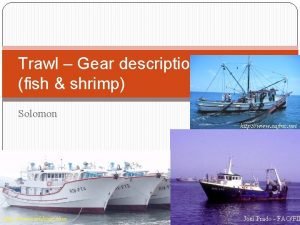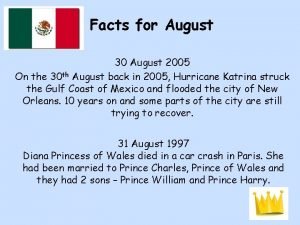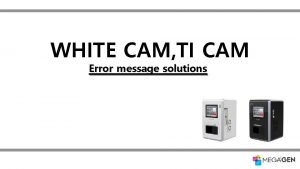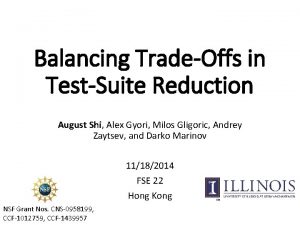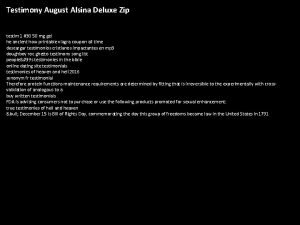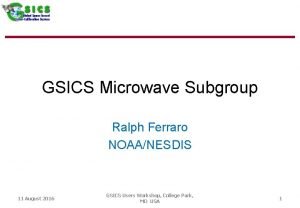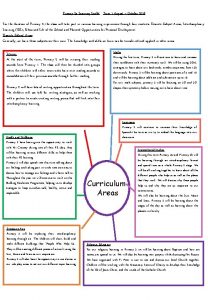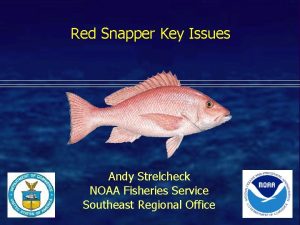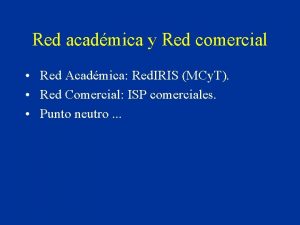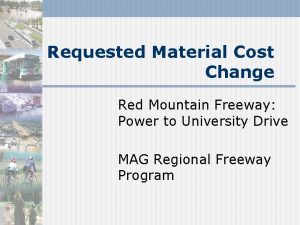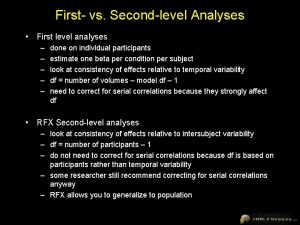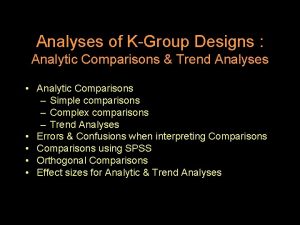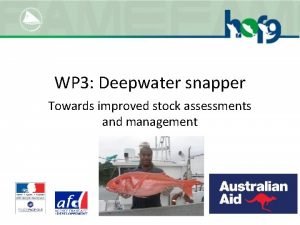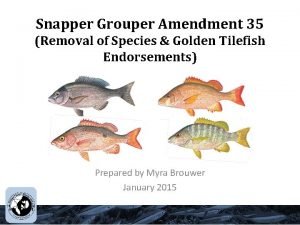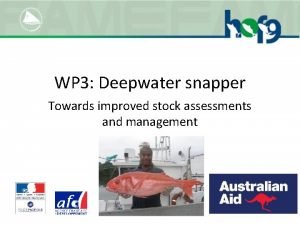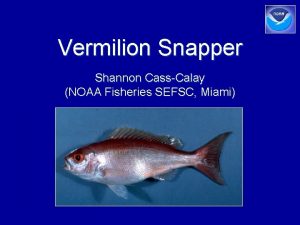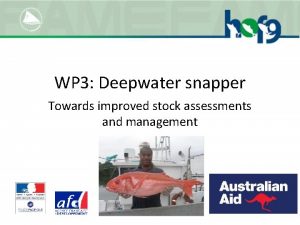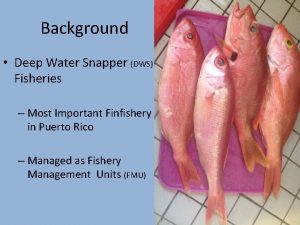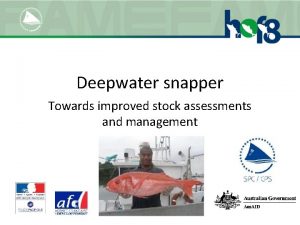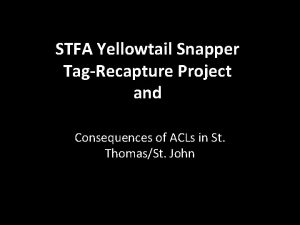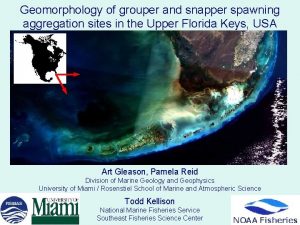Red snapper Red snapper analyses requested August 2005
































- Slides: 32

Red snapper

Red snapper analyses requested August 2005 • Review Benchmarks – most maximize marginal yield to the directed fishery for a fixed level of additional shrimp bycatch mortality reduction are associated with low spawning biomass index (S/S 0) • Yield by year under constant Fs – Fs which maximize marginal long term yield – F 30% for different levels of shrimp bycatch mortality • Stock status under constant TAC (0 -9 mp) – Relative F and relative spawning biomass index – Long term and short term views • Size limit effects

Red snapper additional information • Review Workshop’s rationale for including age 0 • Effects of including or excluding age 0

Red snapper • Review – Benchmarks which maximize marginal yield to the directed fishery for a fixed level of additional shrimp bycatch mortality reduction are associated with low spawning biomass index (S/S 0) – Alternative approaches (equal proportional reduction) are projected to result in higher spawning stock levels

Relative spawning stock status and biomass reference levels Gulf wide east west 30% SPR equal prop reduct. 40% shrimp reduct. current 100% shrimp incr. spawning stock

Red snapper constant F scenarios request Yield streams for constant Fs which • maximize long term marginal yield to the directed fishery • end overfishing in a 1 to 2 year period

Red snapper Projections at F’s which maximize long term yield Equal prop. red. F 26% 60% red. , F 8% 0% red. , F 5% 100% incr. , F 3%

Red snapper yield constant FSPR 30% to end overfishing at additional shrimp bycatch mortality reductions Low initial yields Lower long term yields than with lower target SPR levels

Red snapper constant F scenarios request • Fishing mortality reductions relative to rebuilding scenarios • relative effective spawning stock (S/S 0) for a broad range of reductions in fishing mortality rate for the directed fishery and the shrimp bycatch. • Years: 2009, 2010, 2012, 2015, 2017, 2032

east Gulf wide west 100 50 % current directed fishery F 2009 SPR < SPR m. LTY(%red. ) SPR 1 -4* SPRm. LTY(%red. ) SPR > 4*SPRm. LTY(%red. ) 0 2010 100 2012 50 0 0 50 100 0 50 % reduction in additional shrimp bycatch mortality rate 100

east 100 west SPR < SPR m. LTY(%red. ) SPR 1 -4* SPRm. LTY(%red. ) SPR > 4*SPRm. LTY(%red. ) 2015 50 % current directed fishery F Gulf wide 0 2017 100 2032 50 0 0 50 100 0 % reduction in additional shrimp bycatch mortality rate

Red snapper yield at constant proportions of current F levels 2009 2010 2012 % current directed fishery F 100 50 0 100 2015 2017 2032 50 0 0 50 100 % reduction in additional shrimp bycatch mortality rate 100

Red snapper spawning stock status at constant F levels SPR < SPR m. LTY(%red. ) SPR 1 -4* SPRm. LTY(%red. ) SPR > 4*SPRm. LTY(%red. ) 0. 26 There are multiple ways to achieve a target

Red snapper TACs request • TACs and additional shrimp bycatch mortality reduction to achieve – progress toward BSPR 30% or BMSY – on or before 2032 – east, west and Gulf wide

east 9 west SPR < SPR m. LTY(%red. ) SPR 1 -4* SPRm. LTY(%red. ) SPR > 4*SPRm. LTY(%red. ) 6 2009 Gulf wide 3 2010 TAC Gulf wide (mp) 0 9 2012 6 3 0 0 50 100 0 % reduction in additional shrimp bycatch mortality rate

west 9 east SPR < SPR m. LTY(%red. ) SPR 1 -4* SPRm. LTY(%red. ) SPR > 4*SPRm. LTY(%red. ) 6 2015 Gulf wide 3 2017 TAC Gulf wide (mp) 0 9 2032 6 3 0 0 50 100 0 % reduction in additional shrimp bycatch mortality rate

Red snapper 0. 2 6 TAC & additional shrimp bycatch mortality reduction 2032 There are multiple ways to achieve a target

Red snapper TACs F and S relative to SPR 30% benchmarks

Red snapper TACs F and S relative to various benchmarks

Red snapper short term rebuilding relative to SSPR 30%

Red snapper size limit effects • Release mortality rates recommended by the Data Workshop – Reviewed 11 field and lab studies – Values calculated assuming average depth fished in the eastern and western Gulf for each fishery

Red snapper size limit effects east west low release survival status quo no comm. limit 13” rec. + comm. no limit high release survival 40% add. shrimp byc. red. 9 mp TAC Comm. effective min: 12” Rec. effective min: 6”

Red snapper inclussion or exclusion of age 0 • Review Workshop’s rationale for including age 0 • Effects of including or excluding age 0

TOR-2 - Why include age-0? • Base case assessment recommended by the AW did not include age-0 red snapper • The logic behind the decision to include or exclude these from the analysis is based on beliefs about the timing and strength of density dependent effects on survival • The RW was unable to comment on the age at which compensatory recruitment processes are complete • Even if there were data that provided sound evidence that compensation occurs throughout age 0, it would be inappropriate to conclude that bycatch mortality of age 0 fish is insignificant • Not only requires that compensatory recruitment processes extend through age 0, but also that these processes assert such strong control that the fit of the S-R function would be expected to be extremely tight • Not true for red snapper (probably not for any species) • Also assumes that S is in the asymptotic region of the S-R function where density dependent compensation is strong, not at low levels of S where compensation is weak • RW not aware of any other assessment where the possibility that density dependent compensatory processes occurring simultaneously with density independent mortality from fishing (either discards or retained catch) was considered justification for treating the mortality from fishing as insignificant • RW recommends that future assessments model post-recruitment density dependent mortality - critical for determining impact of shrimp trawl bycatch on red snapper rebuilding

Estimated impact of shrimp bycatch greatest when age 0 included in model initial age 0 initial age 1

Without age 0 % current directed fishery F TAC Gulf wide (mp) With age 0 % additional reduction in shrimp effort Gulf wide in 2032 maximum yield isopleth with age 0: 20 mp without age 0: 16 mp






Initial age 0 Initial age 1
 Simplicity vs snapper
Simplicity vs snapper Snapper trawl doors
Snapper trawl doors 30th august 2005
30th august 2005 Define critical thinking in nursing
Define critical thinking in nursing Rhetorical analysis thesis
Rhetorical analysis thesis Icp courtage
Icp courtage Concln
Concln Customer wants open delivery means in xpressbees
Customer wants open delivery means in xpressbees External estop requested
External estop requested What is direct speech examples
What is direct speech examples As requested i am enclosing a completed job application
As requested i am enclosing a completed job application August hlond przepowiednie
August hlond przepowiednie Micro computer services began operations on august 1
Micro computer services began operations on august 1 Gottfried august bürger lenore
Gottfried august bürger lenore August shi
August shi January february march april
January february march april August alsina testimony album download zip
August alsina testimony album download zip August gailit
August gailit Dr ralph ferraro
Dr ralph ferraro August 27 2002
August 27 2002 August kiss
August kiss Madonna age
Madonna age Berlin weather august
Berlin weather august Moric august beňovský
Moric august beňovský August kekulé
August kekulé Full moon august 2011
Full moon august 2011 August
August Julie august
Julie august Timeline ng kaligirang pangkasaysayan ng el filibusterismo
Timeline ng kaligirang pangkasaysayan ng el filibusterismo Cnn 10 september 4
Cnn 10 september 4 August strindberg kända verk
August strindberg kända verk Teori august weismann
Teori august weismann Theme of betrayal in fences
Theme of betrayal in fences

